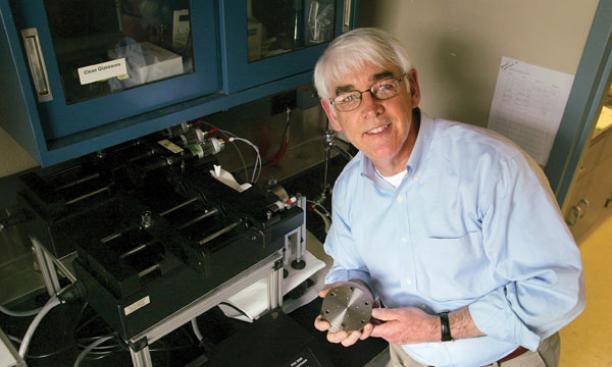

With diameters measured in billionths of a meter, nanoparticles are almost too small to imagine. For example, think of a particle 300 nanometers wide. About 300 such particles, placed side by side, would span the width of one human hair. Now consider an application for which a 300-nanometer particle is simply too large. That is the problem chemical engineering professor Robert Prud’homme faces in one project that aims to efficiently deliver drugs to cancerous tumors.
Prud’homme’s collaborators at Celator, a pharmaceutical firm with labs a few miles from campus, have found that solid tumors are good candidates for nanoparticle drug delivery because their rapid growth rate causes defects in the capillaries that bring blood to the tumor. Particles 100 to 200 nanometers in size can leak through those defects in the capillary walls and embed themselves in a tumor to deliver chemotherapy drugs.
Larger particles would not be able to fit through the tiny leaks in a tumor’s blood vessels, but nanoparticles smaller than 50 nanometers also could be ineffective — and dangerous — because they might deliver toxic drugs throughout the body, not just to tumors.
Additionally, Prud’homme says, “You need really precise control of the particle’s surface chemistry, because you want something that circulates a long time and goes through the cancer tumor many times.” Prud’homme, an expert on the assembly of polymers (large molecules composed of long chains of smaller molecules), has worked with Celator to develop 100- to 200-nanometer particles with a dense, protective outer layer that makes them invisible to the body’s immune system. In studies on laboratory rats, the particles circulated in the body for 18 hours, a marked improvement over the one-hour circulating time for other nanoparticles developed for the same applications.
Prud’homme says his students seem to like the medical applications because they provide opportunities for a “tangible impact on human needs.” One particularly timely project in his lab involves developing a new treatment for tuberculosis, a deadly disease in the developing world, particularly among AIDS patients in Africa. The work, sponsored by the Bill and Melinda Gates Foundation and led by Harvard professor David Edwards, aims to deliver drugs in an inexpensive, easily administered aerosol inhaler, using composite particles of sugar and drug-loaded nanoparticles, to replace the more expensive IV injections required today.
Nanoparticles carry great promise, from drug delivery to improved imaging technologies, but they also present challenges that often require expertise in chemistry, physics, and engineering. Prud’homme has found collaborators in each area, including Princeton colleagues Jamie Link, Doug Adamson, Winston Soboyejo, Robert Austin, Jeffrey Schwartz, and Yiguang Ju.
“We all get together and do things that none of us could do independently,” he says. “It’s a fun, extended family of people who have to come together to make this work.”
